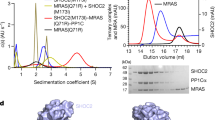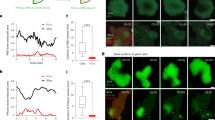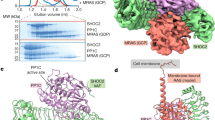Abstract
Ras is frequently mutated in cancer, and novel therapies are being developed to target Ras signalling. To identify non-invasive surrogate markers of Ras activation and inhibition, we used31 P magnetic resonance spectroscopy (MRS) and investigated NIH 3T3 cells compared to a mutant ras transfected counterpart. The MR spectra indicated that phosphocholine (PC) levels increased significantly from 3 ± 2 fmol cell−1 in NIH 3T3 cells to 13 ± 4 fmol cell−1 in the transfected cells. The PC/NTP ratio increased significantly from 0.3 ± 0.1 to 0.7 ± 0.3. This could not be explained by either a faster proliferation rate or by alterations in cell cycle distribution. Both cell lines were treated with simvastatin, 17-AAG and R115777, agents which inhibit Ras signalling. Cell proliferation was inhibited in both cell lines. The spectrum of NIH 3T3 cells was not affected by treatment. In contrast, in the ras transfected cells growth inhibition was associated with an average 35 ± 5% drop in PC levels and a comparable drop in PC/NTP. Thus the MRS visible increase in phosphocholine is associated with Ras activation, and response to treatment is associated with partial reversal of phosphocholine increase in ras transfected cells. MRS might therefore be a useful tool in detecting Ras activation and its inhibition following targeted therapies. © 2001 Cancer Research Campaign
Similar content being viewed by others
Article PDF
Change history
16 November 2011
This paper was modified 12 months after initial publication to switch to Creative Commons licence terms, as noted at publication
References
Aboagye EO and Bhujwalla ZM (1999) Malignant transformation alters membrane choline phospholipid metabolism of human mammary epithelial cells. Cancer Res 59: 80–84
Bhakoo KK, Williams SR, Florian CL, Land H and Noble MD (1996) Immortalization and transformation are associated with specific alternations in choline metabolism. Cancer Res 56: 4630–4634
Bjorkoy G, Overvatn A, Diaz-Meco MT, Moscat J and Johansen T (1995) Evidence for a bifurcation of the mitogenic signaling pathway activated by ras and phosphatidylcholine-hydrolyzing phsopholipase C. J Biol Chem 270: 21299–21306
Boral AL, Dessain S and Chabner BA (1998) Clinical evaluation of biologically targeted drugs: obstacles and opportunities. Cancer Chemother Pharmacol 42: s3–s21
Carnero A, Cuadrado A, Del Peso L and Lacal JC (1994) Activation of D phospholipase by serum stimulation and ras-induced transformation in NIH3T3 cells. Oncogene 9: 1387–1395
Gille H and Downward J (1999) Multiple ras effector pathways contribute to G1 cell cycle progression. J Biol Chem 274: 22033–22040
Heasley LE, Thaler S, Nicks M, Price B, Skorecki K and Nemenoff RA (1997) Induction of cytosolic phospholipase A2 by oncogenic Ras in human non-small cell lung cancer. J Biol Chem 272: 14501–14504
Kiarkis H and Spandidos DA (1995) Mutations of ras genes in human tumours (review). Int J Oncol 7: 413–421
Lacal JC (1990) Diacylglycerol production in Xenopus laevis oocytes after microinjection of p21ras proteins is a consequence of activation of phosphatidylcholine metabolism. Mol Cell Biol 10: 333–340
Lacal JC, Moscat J and Aaronson SA (1987) Novel source of 1,2-diacylglycerol elevated in cells transformed by Ha-ras oncogene. Nature 330: 269–272
Leonard S, Beck L and Sinensky M (1990) Inhibition of isoprenoid biosynthesis and the post-translational modification of pro-p21. J Biol Chem 265: 5157–5160
Lin LL, Wartmann M, Lin AY, Knopf JL, Seth A and Davis RJ (1993) cPlA2 is phosphorylated and activated by MAP kinase. Cell 72: 269–278
Liu JJ, Chao JR, Ming-Chung J, Sun-Yu N, Yen JJY and Yang-Yen HF (1995) Ras transformation results in an elevated level of cyclin D1 and accelerationof G1 progression in NIH 3T3 cells. Mol Cell Biol 15: 3654–3663
Lopez-Barahona M, Kaplan PL, Cornet ME, Diaz Meco MT, Larrodera P, Diaz-Laviada I, Municiao AM and Moscat J (1990) Kinetic evidence of a rapid activation of phosphatidylcholine hydrolysis by Ki-ras oncogene. Possible involvement in late steps of mitogenic cascade. J Biol Chem 265: 9022–9026
Negendank W (1992) Studies of human tumours by MRS: a review. NMR Biomed 5: 303–324
Podo F (1999) Tumour phospholipid metabolism. NMR in Biomed 12: 413–439
Podo F, Ferretti A, Knijn A, Zhang P, Ramoni C, Barletta B, Pini C, Baccarini S and Pulciani S (1996) Detection of phosphatidylcholine-specific phospholipase C in NIH-3T3 fibroblasts and their H-ras transformants: NMR and immunochemical studies. Anticancer Res 16: 1399–1412
Price BD, Morris JDH, Marshall CJ and Hall A (1989) Stimulation of phosphatidylcholine hydrolysis, diacylglycerol release and arachidonic acid production by oncogenic ras is a consequence of protein kinase C activation. J Biol Chem 264: 16638–16643
Ratnam S and Kent C (1995) Early increase in choline kinase activity upon induction of the H-ras oncogene in mourse fibroblast cell lines. Arch Biochem Biophys 323: 313–322
Ronen SM, Rushkin E and Degani H (1992) Lipid metabolism in large T47D human breast cancer spheroids: 31P- and 13C-NMR studies of choline and ethanolamine uptake. Biochim Biophys Acta 1138: 203–212
Ronen SM, DiStefano F, McCoy CL, Robertson D, Smith TAD, Al-Saffar NM, Titley J, Cunningham DC, Griffiths JR, Leach MO and Clarke PA (1999) Magnetic resonance detects metabolic changes associated with chemotherapy-induced apoptosis. Br J Cancer 80: 1035–1041
Schulte TW and Necker LM (1998) The benzoquinone ansamycin 17-allylamino- 17-demethoxygeldanamycin binds to HSP90 and shares important biologic activities with geldanamycin. Cancer Chemother Pharmacol 42: 273–279
Smith TA, Eccles S, Ormerod MG, Tombs AJ, Titley JC and Leach MO (1991) The phosphocholine and glycerophosphocholine content of an oestrogen-sensitive rat mammary tumour correlates strongly with growth rate. Br J Cancer 64: 821–826
Teegarden D, Taparowsky EJ and Kent C (1990) Altered phosphatidylcholine metabolism in C3H10T cells transfected with the Harvey-ras oncogene. J Biol Chem 265: 6042–6047
Ting Y-LT, Sherr D and Degani H (1996) Variations in energy and phosphlipid metabolism in normal and cancer human mammary epithelial cells. Anticancer Res 16: 1381–1388
Tyagi RK, Azrad A, Degani H and Salomon Y (1996) Simultaneous extraction of cellular lipids and water-soluble metabolities: evaluation by NMR spectroscopy. Magn Reson Med 35: 194–200
Weiprecht M, Weider T, Paul C, Geilen CC and Orfanos CE (1996) Evidence for phosphorylation of CTP:phosphocholine cytidyltrasferase by multiple proline directed protein kinases. J Biol Chem 271: 9955–9961
Zujewski J, Horak ID, Bol CJ, Woestenborghs R, Bowden C, End DW, Piotrovsky VK, Chiao J, Belly RT, Todd A, Kopp WC, Kohler DR, Chow C, Noone M, Hakim FT, Larkin G, Gress RE, Nussenblatt RB, Kremer AB and Cowan KH (2000) Phase I and Pharmacokinetic Study of Farnesyl Protein Transferase Inhibitor R115777 in Advanced Cancer. J Clin Oncol 18: 927–928
Author information
Authors and Affiliations
Rights and permissions
From twelve months after its original publication, this work is licensed under the Creative Commons Attribution-NonCommercial-Share Alike 3.0 Unported License. To view a copy of this license, visit http://creativecommons.org/licenses/by-nc-sa/3.0/
About this article
Cite this article
Ronen, S., Jackson, L., Beloueche, M. et al. Magnetic resonance detects changes in phosphocholine associated with Ras activation and inhibition in NIH 3T3 cells. Br J Cancer 84, 691–696 (2001). https://doi.org/10.1054/bjoc.2000.1663
Received:
Revised:
Accepted:
Published:
Issue date:
DOI: https://doi.org/10.1054/bjoc.2000.1663
Keywords
This article is cited by
-
The relevance of tyrosine kinase inhibitors for global metabolic pathways in cancer
Molecular Cancer (2018)
-
Metabolite profiling in retinoblastoma identifies novel clinicopathological subgroups
British Journal of Cancer (2015)
-
Monitoring response to cytostatic cisplatin in a HER2(+) ovary cancer model by MRI and in vitro and in vivo MR spectroscopy
British Journal of Cancer (2014)
-
Prognostic value of metabolic response in breast cancer patients receiving neoadjuvant chemotherapy
BMC Cancer (2012)
-
Molecular imaging of tumor metabolism and apoptosis
Oncogene (2011)



